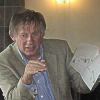Christopher Alexander

Christopher Alexander
Christopher Wolfgang Alexander is a widely influential architect and design theorist, and currently emeritus professor at the University of California, Berkeley. His theories about the nature of human-centered design have had notable impacts across many fields beyond architecture, including urban design, software, sociology and other fields. Alexander has also designed and personally built over 100 buildings, both as an architect and a general contractor...
NationalityAmerican
ProfessionArchitect
Date of Birth4 October 1936
CountryUnited States of America
To work our way towards a shared language once again, we must first learn how to discover patterns which are deep, and capable of generating life.
From a sequence of these individual patterns, whole buildings with the character of nature will form themselves within your thoughts, as easily as sentences.
The specific patterns, out of which a building or a town is made may be alive or dead. To the extent they are alive, they let our inner forces loose, and, set us free; but when they are dead they keep us locked in inner conflict.
In short, no pattern is an isolated entity. Each pattern can exist in the world only to the extent that is supported by other patterns: the larger patterns in which it is embedded, the patterns of the same size that surround it, and the smaller patterns which are embedded in it.
Adequate information about the existing environment and about the types of place that it is desirable to make cannot be kept inside one brain.
We define organic order as the kind of order that is achieved when there is a perfect balance between the needs of the parts, and the needs of the whole.
A building or a town will only be alive to the extent that it is governed in a timeless way. It is a process which brings order out of nothing but ourselves; it cannot be attained, but it will happen of its own accord, if we will only let it.
There are some geologists involved with prospecting for oil and other hidden resources who can pick up a rock and say, 'Yes, there's oil under there.' A geologist who has been studying those kinds of rocks for 10 or 20 years is able to make that pronouncement.
This is a fundamental view of the world. It says that when you build a thing you cannot merely build that thing in isolation, but must repair the world around it, and within it, so that the larger world at that one place becomes more coherent, and more whole; and the thing which you make takes its place in the web of nature, as you make it.
I mean, making simulations of what you're going to build is tremendously useful if you can get feedback from them that will tell you where you've gone wrong and what you can do about it.
To seek the timeless way we must first know the quality without a name. There is a central quality which is the root criterion of life and spirit in a man, a town, a building, or a wilderness. This quality is objective and precise, but it cannot be named.
On the geometric level, we see certain physical elements repeated endlessly, combined in an almost endless variety of combinations... It is puzzling to realize that the elements, which seem like elementary building blocks, keep varying, and are different every time that they occur .... If the elements are different every time that they occur, evidently then, it cannot be the elements themselves which are repeating in a building or town; these so-called elements cannot be the ultimate "atomic" constituents of space.
It is a common experience that attempts to solve just one piece of a problem first, then others, and so on, lead to endless involutions. You no sooner solve one aspect of a thing, than another point is out of point. And when you correct that one, something else goes wrong. You go round and round in circles, unable to produce a form that is thoroughly right.
There are geologists who can pick up a rock and say, 'Yes, there's oil under there.' A geologist who has been studying those kinds of rocks for 10 or 20 years is able to make that pronouncement.